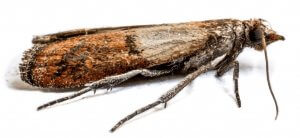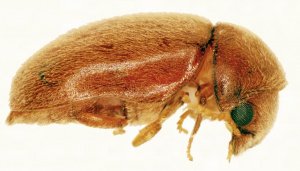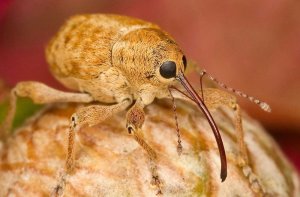Pantry pests is a most unimaginative moniker for insects that like to hang out in your pantry.
Also known by the equally humdrum name, Stored Product Pests, these critters have an insatiable appetite for the dried and processed food products that are stored in your home.
They can include: flour; cereal; powdered milk; pasta; dry pet food; cornstarch; crackers; spices; bread; bird seed; dried nuts; fruit and more.
Pantry pests can breed almost continuously, as they tend to live inside the food products they thrive on.
They can produce several generations over the course of a single year.
Some Common Pantry Pests Found In Homes
Pantry pests include a variety of insects, the most common of which are: the Indian Meal Moth, the Saw-Toothed Drain Beetle, the Flour Beetle, weevils and the Cigarette Beetle are most commonly found in kitchens and homes.
The following paragraphs detail these various types of pantry pests.
What is an Indian Meal Moth?
In an odd twist of fate, Indian meal moths are probably the most common pests the average homeowner doesn’t know by name.
Also known as weevil moth, pantry moth, flour moth or grain moth, according to Penn State University’s Department of Entomology: “The Indian meal moth is one of the most commonly reported pests of stored grains in the United States.
Even when compared to other household pests and other types of moths, this critter is unstoppable once it considers your pantry its very own “home sweet home.”
Common pantry foods are far more vulnerable than might otherwise be expected because the larvae of the Indian Meal Moth can easily eat through plastic and cardboard.
Sealing stored food in plastic bags and boxes is really not much protection against these voracious pests.
They are cosmopolitan critters that prefer tropical climates but they are found all over the world except Antarctica.
This moth is by far, the most common and destructive stored food pest found in the United States today.

They do all their damage during their larval stages because it is at this stage in development that they eat every second they are alive.
These moths lay eggs on or near food to insure the larvae will have something to eat the moment they hatch.
These critters can easily eat through cardboard and soft plastic.
Only airtight hard plastic containers can keep these stored food pests from infesting stored grains.
Home owners should watch out for crumbs accumulating in a pantry, as they can attract pantry pests.
Indian meal moths are also more mobile than other pest invaders.
This translates into the most disturbing realization that just because you once saw them around your pantry and now you don’t doesn’t mean you no longer have an infestation.
As a homeowner, you still need help with pest-management and pest-control strategies, such as those Pestco can offer.
But even the experts do not have an easy road ahead of them, as Indian meal moths have developed biological resistances to various pest-control measures.
In their own horrible way, Indian meal moths have actually out-evolved modern science!
There are a variety of beetles that can make their way into a residence and pantry, but the most common are saw-tooth grain beetles, flour and confused flour beetles, cigarette beetles and various types of weevils.
Further information is listed below.
The Red Flour Beetle and The Confused Flour Beetle
Even though they are two entirely different species, they are so similar that the confused flour beetle was so named because it is often “confused” with its red flour cousin.
Without the aid of a magnifying glass, it is difficult to tell the two apart.
The Red Flour Beetle is of Australian origin, and is found worldwide in warm climates, but it can survive the winter months in homes where central heating provides protection from the cold.
The Confused Flour Beetle originated in Africa and its distribution occurs mostly in colder climes. Both species attack stored grain products in homes and grocery stores.
These include: flour; cereals; crackers; beans; spices; pasta; cake mix; dried pet food; dried flowers; chocolate; nuts; seeds and even dried museum specimens.
The Saw-Toothed Grain Beetle
These pantry pests are known to attack almost any dry food under the sun, but they are most likely to be found in cereal products such as flour; cake mix; cornmeal; macaroni and other pantry products such as bread; dried fruits; nuts; chocolate and dry pet food.
Like other species of pantry pests, it is the larvae that cause the damage and contamination of food stuffs.
It is the adult insect, however, that is most encountered by humans, as they are known to to gain ingress via sealed (and broken) cardboard boxes and soft plastic packages.
The Cigarette Beetle
The cigarette beetle is known all over the modern world and is found especially wherever dried tobacco in the form of leaves, cigars, cigarettes, or chewing tobacco is stored.
These pests have caused severe economic losses to many businesses including: flour mills; bakeries; pet food factories; cereal manufacturing centers; snack food plants; chocolate factories; confectionaries; wholesale distribution centers; and sometimes retail stores.

In addition to being the most damaging pest of stored tobacco, the cigarette beetle is a major invader and destroyer of many stored food products kept in kitchen cabinets, pantries and other areas in the average home.
These include: flours; dry mixes; dried fruits like dates and raisins; cereals; coffee beans; herbs; spices; nuts; rice and dry pet food.
These insect invaders evoke disgust and anger to all who find them ruining products purchased with hard-earned money.
Just when homeowners might think that other items in their home might be safe, they discover that these destructive pests infest non-food products as well.
Some of these include: dried floral arrangements; potpourri; decorative grapevine wreaths; prescription drugs and pills; medicinal herbs; furniture stuffing; papier-mâché items and bookbinding paste.
Our integrated pest management (IPM) solutions are often implemented to control these infestations for homes throughout Pittsburgh.
Weevils
These small reddish brown beetles known for their elongated snouts, are often found in kitchen cupboards and pantries.
Unlike beetles that live and feed on foods, weevils live and feed inside the food.
In an average residence, weevils can be brought in on packaged products or they can enter from outside.
Once inside, they multiply rapidly and can quickly destroy stored food items if they are not controlled by pest specialists.

10 Prevention Tips To Guard Against Pantry Pests
Eliminating pantry pests from your residence can be a difficult task and is usually not accomplished without the backing of your local professional pest control and pest-management experts.
If you’re in the Greater Pittsburgh, Allegheny County area, that means calling the technicians at Pestco Professional Services! (412) 252-5200
The major problem is finding the source of the infestation because these insects naturally blend in with their environment, making them difficult to identify.
Preventing their ingress into your home us the best way to deal with these stored product pests. Consider the following helpful tips listed below.
1) Store Dry Food In Air-Tight Containers
One way to minimize the risk of pantry pest infestations is to ensure that all food products are stored in air-tight containers and that your pantry or cupboards are kept clean and free of food that may be left open or not closed properly.
This prevents any existing pests from contaminating newer products.
Remove dry pantry foods and bulk foods from original containers and store them instead in tight-fitting containers.
Also, don’t forget to clean old containers before filling them with fresh food.
2) Do Not Store Old And New Products Together
Never combine older and new dry food products unless you’re absolutely sure both products are pest-free.
This is because if the older food materials are infested, the newer ones will soon be.
3) Avoid Buying Damaged Food Boxes of Any Kind
When food shopping, do not purchase boxes that already look damaged and inspect all bags/boxes prior to purchasing to ensure that they are securely sealed.
In addition, be wary when purchasing specialty items such as international foods, holiday specialty items, i.e. matzah meal, corn meal etc.
These types of products often sit on store shelves longer than staple food items and are highly susceptible to grain pest infestation.
4) Always Check Expiration Dates On Food In Your Pantry
Periodic checks on food in the pantry will help to organize older items that might have lost their way to the dining room table.
Dispose of any food that is past its expiration date and/or has been stored for a long period of time.
5) Add Bay Leaves To Canisters And Packages In Your Pantry
This herb deters pantry pests in general because its aroma is pungent and distasteful to most stored food pests.
Place whole bay leaves on counter tops, under cabinets and appliances, around trash cans and along baseboards.
6) Be Careful When Buying Bulk Food Items
Grains, spices, rice, dry pet foods, birdseed, bird suet and other products often sold in bulk are particularly vulnerable to pantry pest infestations.
Beware of moths or beetles seen on shelves or flying in the air when walking down store aisles.
These are true indicators of an infestation.
7) Clean Pantry Shelves Regularly
Removing the small bits of food that pantry pests thrive on helps to eliminate their food source.
As an extra safety measure, wash the shelves, walls, and corners thoroughly before returning any items to the pantry.
8) Keep Food Storage Units Dry At All Times
This is very important because moisture attracts pantry pests.
Homeowners should keep food storage areas dry via a fan or dehumidifier.
9) Pesticides Are Not Recommended For Pantry Pest Control
The application of bleach, ammonia or pesticides will not prevent an infestation and can be dangerous if they accidentally come in contact with foods.
10) Call For Pest Control Professional Help!
The problem with pantry pest infestations is that they are usually bigger and more complex than than the average lay person can handle, so calling your local pest control company is the best option.
If you’re in or around Allegheny County (Greater Pittsburgh), the best pro-active approach is to call Pestco Professional Services right away – (412) 252-5200!
Pestco Professional Services Solutions
The first action our highly trained technicians will take will be to locate the source of the infestation. Effective pest-control and pest-management solutions begins at this point.
This process can be very complex, as in order to resolve the problem, all the eggs, larvae, and adults infesting your home or establishment must be found and eliminated.
Based on the findings, our pest control experts will implement a unique treatment plan that will both eliminate the current infestation and prevent future problems with pantry pests within your home.
So give us a call today (412) 252-5200 and save your stored food products today, tomorrow and always.

A Few More Interesting Facts About Pantry Pests
Indian Meal Moths Can Generate 9 Generations In 12 Months
This is why best control experts must be notified as soon as an infestation is discovered. The Indian Meal Moth can produce up to 300 eggs from a single breeding. This is a staggering amount especially when considering that adult moths typically only live long enough to mate and lay eggs.
Pantry Pests Gain Ingress To Homes In One Of Two Ways
These invaders can either find their way on their own or the hapless homeowner can unknowingly bring them in. Keeping these pests out starts in the grocery store where items are purchased, Never buy a package that is ripped or torn or contains food that is expired.
They Can Be Inside Your Food Long Before They Are Seen
Pantry pests can be invisible to the naked eye both as larvae and adults. This translates into a most disgusting possibility. Due to the fact that these critters look so similar to the food they love to eat it is possible that an unknowing human could mistakenly ingest some of these insects. The best way to avoid that is to cycle the
food in your pantry. Eat the older items first, store all pantry products in hard plastic containers, and keep the pantry clean and dry at all times.
Adult Female Saw-Toothed Grain Beetles Are Prolific Breeders
These insects can deposit up to 400 eggs over a lifespan that may be as long as two years. For this reason, the early intervention by the pest-control and pest-management specialists at Pestco is a vitally important move for homeowners to make.
The Cigarette Beetle Dates Back Many Centuries
The cigarette beetle has long been associated with humans and some remains were found in dried resin inside the gilded tomb of the Egyptian King, Tutkanhamun.
There Are About 97.000 Known Species Of Weevils
They belong to several insect families, with most of them in the Curculionidae category. There also different types, some which include: rice weevils; seed weevils; granary/grain weevils; maize weevils, and bean/pea/seed weevils. But the “true” weevils, with the snout nose, are the granary, rice, and maize weevils.
The Names Weevil Indicates The Plant They Can Be Found On
While not always the case, in most instances their names reveals where they can be found. Red palm weevils feed on types of palm trees and vine weevils are often found on ornamental and container plants. They are considered to be major garden pests. The list goes on with maize and rich weevils etc.
Weevils Damage Is Often Mistaken For Grasshopper Damage
Because some types of weevils feed along the edges of plant leaves and grasses, the signs of their damage are much the same as a grasshopper, which consists of
ragged, chewed holes in the leaves, stems and fruit of plants.
Several Species Of Weevils Can Fly
Unlike most of their beetle relatives, some weevil species, particularly the red palm weevil, can fly. Scientists have observed adults flying more than one-half mile per day in search of feeding and mating locations.
Weevils Do Not Feed On Processed Food Products
This highlights a significant difference between beetles and weevils. Weevils often feed on corn meal, whole grains, seeds or beans.
Photo Credits: Pixabay
 Over 300 Reviews
Over 300 Reviews 